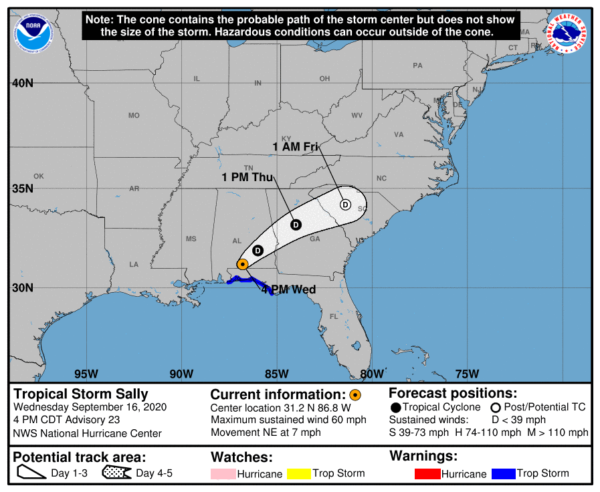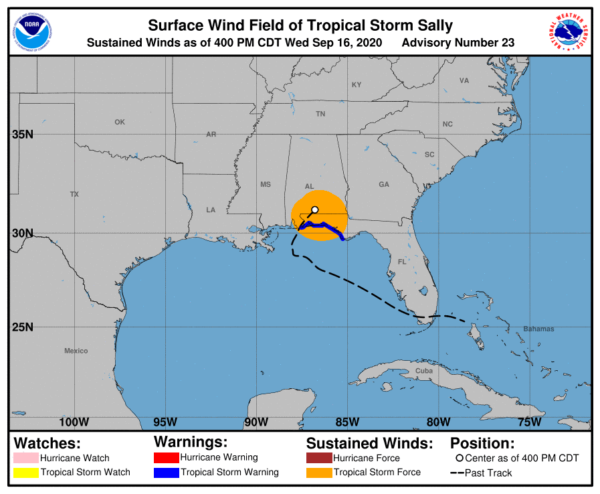Sally Continues to Weakens; Catastrophic & Life-Threatening Flooding Occurring in Southern Alabama & Portions of the Florida Panhandle
BULLETIN
Tropical Storm Sally Advisory Number 23
NWS National Hurricane Center Miami FL AL192020
400 PM CDT Wed Sep 16 2020
SUMMARY OF 400 PM CDT…2100 UTC…INFORMATION
———————————————-
LOCATION…31.2N 86.8W
ABOUT 55 MI…85 KM NNE OF PENSACOLA FLORIDA
ABOUT 85 MI…135 KM W OF DOTHAN ALABAMA
MAXIMUM SUSTAINED WINDS…60 MPH…95 KM/H
PRESENT MOVEMENT…NE OR 35 DEGREES AT 7 MPH…11 KM/H
MINIMUM CENTRAL PRESSURE…990 MB…29.23 INCHES
WATCHES AND WARNINGS
——————–
A Storm Surge Warning is in effect for…
* Alabama/Florida border to the Walton/Bay County Line Florida
A Tropical Storm Warning is in effect for…
* Alabama/Florida border eastward to Indian Pass Florida
DISCUSSION AND OUTLOOK
———————-
At 400 PM CDT (2100 UTC), the center of Tropical Storm Sally was located near latitude 31.2 North, longitude 86.8 West. Sally is moving toward the northeast near 7 mph (11 km/h), and a northeastward motion at a slightly faster forward speed is expected tonight through Thursday night. On the forecast track, the center of Sally will move across southeastern Alabama tonight, over central Georgia on Thursday, and move over South Carolina Thursday night.
Maximum sustained winds have decreased to near 60 mph (95 km/h) with higher gusts. Additional weakening is expected as the center moves farther inland tonight, and Sally is forecast to become a tropical depression tonight or Thursday morning.
Tropical-storm-force winds extend outward up to 125 miles (205 km) from the center.
The estimated minimum central pressure is 990 MB (29.23 inches).
HAZARDS AFFECTING LAND
———————-
RAINFALL: Sally has produced storm totals of 10 to 20 inches, with isolated amounts of 30-35 inches, across the central Gulf Coast from the Florida Panhandle west of Tallahassee to Mobile Bay, Alabama. Historic and catastrophic flooding, including widespread moderate to major river flooding, will continue across this region. Additional rainfall of 1 to 4 inches is possible across the Florida Panhandle from Tallahassee to the Apalachicola River.
Rainfall totals expected as Sally tracks across the Southeast through Friday:
Southern Alabama and central Georgia: 4 to 8 inches with isolated amounts of 12 inches, resulting in significant flash flooding and widespread minor to moderate and isolated major river flooding.
Central to upstate South Carolina: 4 to 7 inches, with isolated amounts of 10 inches. Widespread flash flooding and minor to moderate river flooding is possible.
Western to central North Carolina and far southeast Virginia: 4 to 6 inches, isolated amounts up to 8 inches. Scattered flash flooding and widespread minor river flooding is possible.
STORM SURGE: The combination of a dangerous storm surge and the tide will cause normally dry areas near the coast to be flooded by rising waters moving inland from the shoreline. The water could reach the following heights above ground somewhere in the indicated areas if the peak surge occurs at the time of high tide…
AL/FL Border to Walton/Bay County Line, FL including Pensacola Bay and Choctawhatchee Bay…2-4 ft
Walton/Bay County Line, FL to Chassahowitzka, FL including Saint Andrew Bay…1-3 ft
The deepest water will occur along the immediate coast in areas of onshore winds, where the surge will be accompanied by large and damaging waves. Surge-related flooding depends on the relative timing of the surge and the tidal cycle and can vary greatly over short distances.
WIND: Tropical storm conditions will continue in portions of the warning area tonight.
TORNADOES: A few tornadoes may occur this afternoon and tonight across portions of northern Florida and southern Georgia. The threat of tornadoes will shift northeastward into parts of eastern Georgia and much of the Carolinas on Thursday.
SURF: Swells from Sally will continue to affect the Gulf Coast from the Florida Big Bend westward to southeastern Louisiana during the next day or so. These swells are likely to cause life-threatening surf and rip current conditions.
Category: Alabama's Weather, ALL POSTS, Severe Weather, Tropical




















